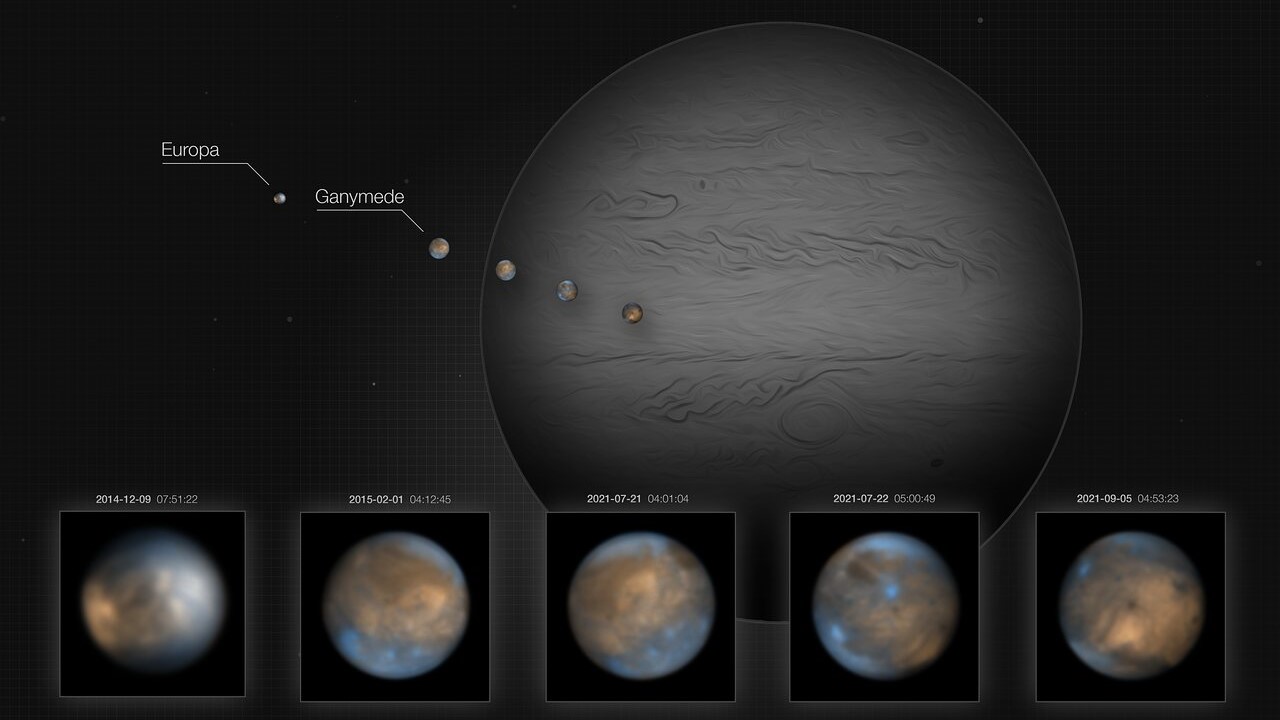Clearest images yet of Europa and Ganymede from Earth show Jupiter's icy moons in detail
The images show the moons' compositions and geological features and will support upcoming space missions.

Astronomers have revealed the most stunning and detailed images of two of Jupiter's largest moons ever obtained from the surface of Earth.
The images show the icy surfaces and details of the processes that shape the chemical composition of Europa and Ganymede, two of Jupiter's four Galilean moons, which are named after the astronomer who first observed them. And scientists hope that the new images, captured by the Very Large Telescope (VLT) in Chile, will lay the groundwork for future space missions focused on these worlds.
The highly detailed observations reveal geological features on the two frozen Jovian moons including a long, rift-like marking that cuts across the surface of Europa, a type of deformation referred to by planetary scientists as a "linae."
Related: Juno photos reveal more stunning glimpses of Jupiter's ice-covered moon Europa
Both the observations of Europa, which is around the size of Earth's moon, and of Ganymede, the solar system's largest moon and larger than Mercury, record the amount of sunlight reflected from the moons' icy surfaces. This observation produces what astronomers call a reflectance spectrum, which they can then analyze via a process called spectroscopy to reveal the chemical "fingerprints" of specific elements. These reflectance spectra allowed the scientists to determine the chemical composition of both Jovian moons.
The analysis of Europa showed that its crust is primarily composed of frozen water ice with non-ice materials, including a variety of different salts that reflectance spectroscopy couldn't identify, across its surface.
"We mapped the distributions of the different materials on the surface, including sulfuric acid frost, which is mainly found on the side of Europa that is most heavily bombarded by the gasses surrounding Jupiter," team leader and University of Leicester School of Physics and Astronomy Ph.D. student Oliver King, said in a statement. "The modeling found that there could be a variety of different salts present on the surface but suggested that infrared spectroscopy alone is generally unable to identify which specific types of salt are present."
Breaking space news, the latest updates on rocket launches, skywatching events and more!
The team's observations of Ganymede, meanwhile, revealed two types of terrain across the moon's surface. Younger areas were marked by large amounts of water ice than much older regions, which are made up of a dark gray material that the team has not yet been able to identify.
Seen as blue-colored areas in the VLT image, the icy regions of Ganymede include its polar ice caps and craters where asteroid impacts have freshly exposed the ice that makes up the Galilean moon's crust. King and his colleagues also used the images to map the size of ice grains across Ganymede's surface and determine how different salts may be distributed over it.
"[The VLT] has allowed us to carry out detailed mapping of Europa and Ganymede, observing features on their surfaces smaller than 150 kilometers [90 miles] across — all at distances over 600 million kilometers [370 million miles] from the Earth," King said. "Mapping at this fine scale was previously only possible by sending spacecraft all the way to Jupiter to observe the moons up close."
This research doesn't mean that future missions to these moons are off the table, however. On the contrary, this mapping of Europa and Ganymede makes the prospect of these spacecraft missions even more enticing.
Setting the scene for future exploration
Leigh Fletcher supervised the VLT investigation of Europa and Ganymede and is also a member of the science teams for ESA's Jupiter Icy Moons Explorer (JUICE) and NASA's Europa Clipper mission, each set to explore these Jovian moons in the early 2030s.
The missions will begin when JUICE launches in 2023 to study Europa and Ganymede, as well as a third Jovian moon, Callisto, plus the gas giant's atmosphere and magnetic field.
"These ground-based observations whet the appetite for our future exploration of Jupiter's moons," Fletcher said. "Planetary missions operate under tough operating constraints and we simply can't cover all the terrain that we'd like to, so difficult decisions must be taken about which areas of the moons' surfaces deserve the closest scrutiny." Now, those decisions can incorporate additional context.
NASA's Europa Clipper mission will follow JUICE to the launch pad in 2024 and will focus on determining whether the ocean hiding below the moon's icy surface has conditions favorable to life. Unlike JUICE, Europa Clipper will keep its focus firmly on Europa, analyzing both the internal ocean and the dynamics of the ice shell.
The team's work is published in two separate papers; the Europa research is detailed in The Planetary Science Journal and the team's Ganymede findings are discussed in a paper accepted for publication in the journal JGR: Planets and currently available on preprint server ArXiv.
Follow us on Twitter @Spacedotcom and on Facebook.

Robert Lea is a science journalist in the U.K. whose articles have been published in Physics World, New Scientist, Astronomy Magazine, All About Space, Newsweek and ZME Science. He also writes about science communication for Elsevier and the European Journal of Physics. Rob holds a bachelor of science degree in physics and astronomy from the U.K.’s Open University. Follow him on Twitter @sciencef1rst.

